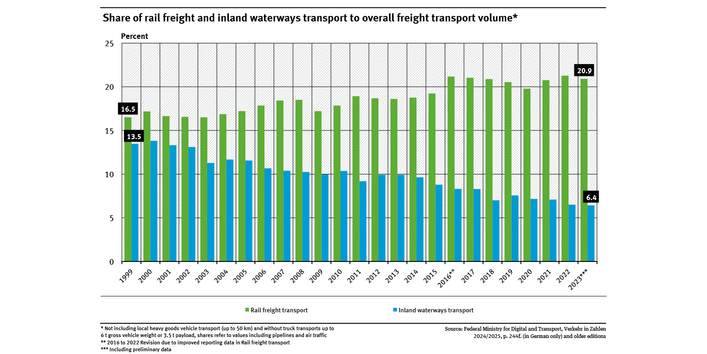At a glance
- The rail share in freight transport fluctuated between 19 % and 21,5 % over the past years.
- The share of inland waterways transport fell almost continuously from 13.5 % to 6.4 % since 1999.

- The rail share in freight transport fluctuated between 19 % and 21,5 % over the past years.
- The share of inland waterways transport fell almost continuously from 13.5 % to 6.4 % since 1999.
Almost three quarters of the total freight transport is managed by road. However, shifting transport to more environmentally friendly modes such as ships and trains is a prerequisite for sustainable freight transport.
It has to be said that trains and ships pose their own environmental challenges. Rail freight transport causes noise pollution, while inland waterways transport require well maintained waterways. Extending waterways is often associated with a decline in water quality and a burden on the natural environment, but energy consumption per tonne-kilometre is on average significantly lower in rail and ship transport than in heavy goods vehicle transport. The same applies to greenhouse gas emissions (in German only).
For short distances under 50 kilometres, motorised freight transport is almost unrivalled. Trains and ships are unsuitable for extensive distribution of goods. This is why for this indicator, only goods transport over distances above 50 kilometres are taken into account. For local and distribution transport light duty utility vehicles with electric drive and cargo bikes, among other things, are a more environmentally friendly alternative.
The long-term development of rail freight transport was positive. Its share increased slightly between 1999 and 2015 from 16.5 % to 19.2 %. From 2016, there was a jump due to a change in the data basis and in recent years the proportion has fluctuated between 19 and 21.5 %. In inland waterways transport, the trend has been clearly negative. Between 1999 and 2023, its freight transport market share fell almost continuously. Overall, the share of freight transport by rail and inland waterways in total freight transport volume has declined slightly due to the strong growth of road freight transport.
Measures taken by the Federal Government could not prevent the ever-increasing dominance of road based freight transport. Clearly, more efforts must be made. From an environmental perspective, goods traffic as such should be reduced. At present, however, an ongoing increase is to be expected.
The figures on which this indicator is based are published annually by the Federal Ministry for Digital and Transport in its series 'Verkehr in Zahlen' (in German only). They are largely based on data that have been published by the Federal Statistical Office of Germany in its publication 'Verkehr aktuell' (in German only) and its 'Database “GENESIS ONLINE'. Descriptions on the methods used are found in the quality reports of the Federal Statistical Office of Germany. Figures on road freight transport are based on data collected by the Federal Motor Transport Authority.
More detailed information: Fahrleistungen, Verkehrsleistung und Modal Split in Deutschland (in German only).